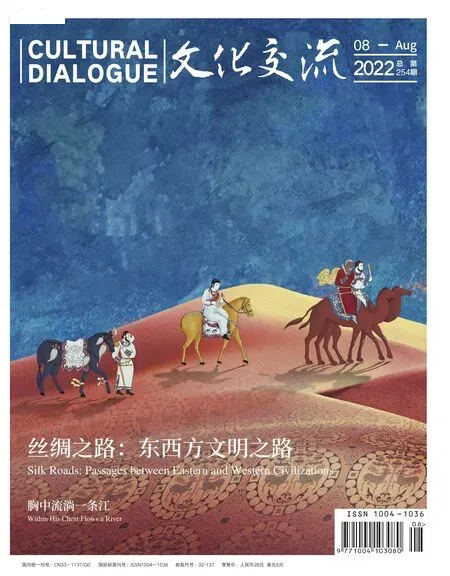青绿与少年
文 /孙 雯
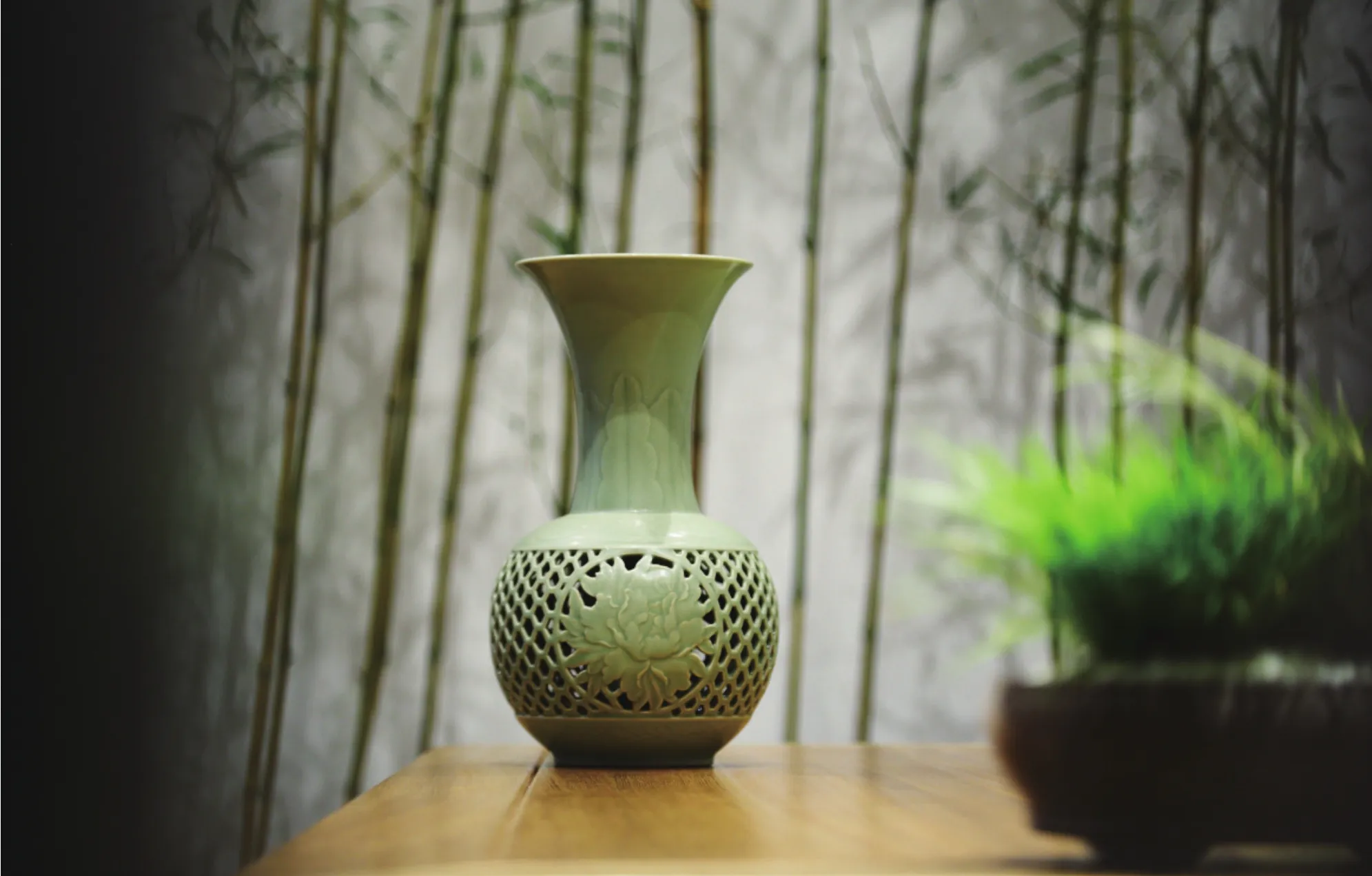
慈溪越窑青瓷烧制技艺传承人孙威的作品《落日——牡丹天球瓶》。Sunset — Peony Vase, a work by Sun Wei, inheritor of the Cixi Yue kiln site celadon- firing craft.
宋代不远。
在台州黄岩沙埠竹家岭下,似乎只要穿过那位安保大哥锐利的眼神,就能落脚于宋代的大地上。即使不曾跨进那一扇铁栅门,在山脚下的柏油路旁,一抬头,也能望见它。
黄岩窑,从西周时期开始,历经了三次集中生产高潮,遗留下埠头堂、下圆山、沙埠三处从东汉至两宋时期相对连续的窑址群。其中,沙埠窑青瓷烧造时间长,规模大,堪称浙东一大青瓷名窑。而沙埠竹家岭窑址的“龙窑”盘踞在山坡上,由它烧制出的盘碗钵盂,盛出千年前沙埠溪畔那些热气腾腾的百姓生活。之后,深浅不一的青绿,顺水而行,去永宁江,去椒江,再乘东海的碧波,去往日本、高丽(新安)、菲律宾、印尼等国,行至世界。
站在山顶高翘的“龙尾”处转身俯瞰—
山峦之间,有大片平地,如同北宋少年画家王希孟笔下“千里江山”的平阔之处。可以想见,几百年前的今天,那里定是水波荡漾,舟船往来。
初夏到黄岩,满眼亦是青绿,其间,浅色的花树从密林中站了出来,正如竹家岭窑址出土的两宋青瓷,绿得合乎时令,又让铮铮铁骨的精气神儿在釉面上开出了冰花。
去黄岩之前,我还去了一趟慈溪。
从上林湖到沙埠溪,在夏天里回忆冬天的行程,只有东海边的这一趟“寻瓷之旅”,稳坐于脑海之中。
慈溪的瓷与黄岩的瓷,若以专业的眼光去看,有诸多不同。但如我这样的普通观者,只是爱它们流畅的青绿色调,深绿浅绿,带有匠人的庄重或俏皮。
当然,青绿与青绿是不同的。
同是对“千峰翠色”的孜孜以求,上林湖与沙埠都留下满载时光密码的器物,它们端坐于博物馆的玻璃柜中,以安静的讲述等候懂它的人。
它们等来的人,不但懂它,还使之重生。
不知是否巧合,在我踏进那些古窑址附近的村子时,总会遇到“隐居”的年轻人。他们操持着这片土地上古老的物事,当然,理念是新的,设备也是新的。他们以满腔热切,将凝聚中国人最高审美的器物,置于今天更广泛的日常。
在上林湖畔的匡堰镇倡隆村,我遇到孙威。其时,他正小心翼翼地将几只青瓷小件从窑炉中取出,捧到工作室的大桌子上。

台州黄岩沙埠窑遗址(竹家岭窑址)。The Shabo kiln (Zhujialing kiln) site in Huangyan district, Taizhou city.
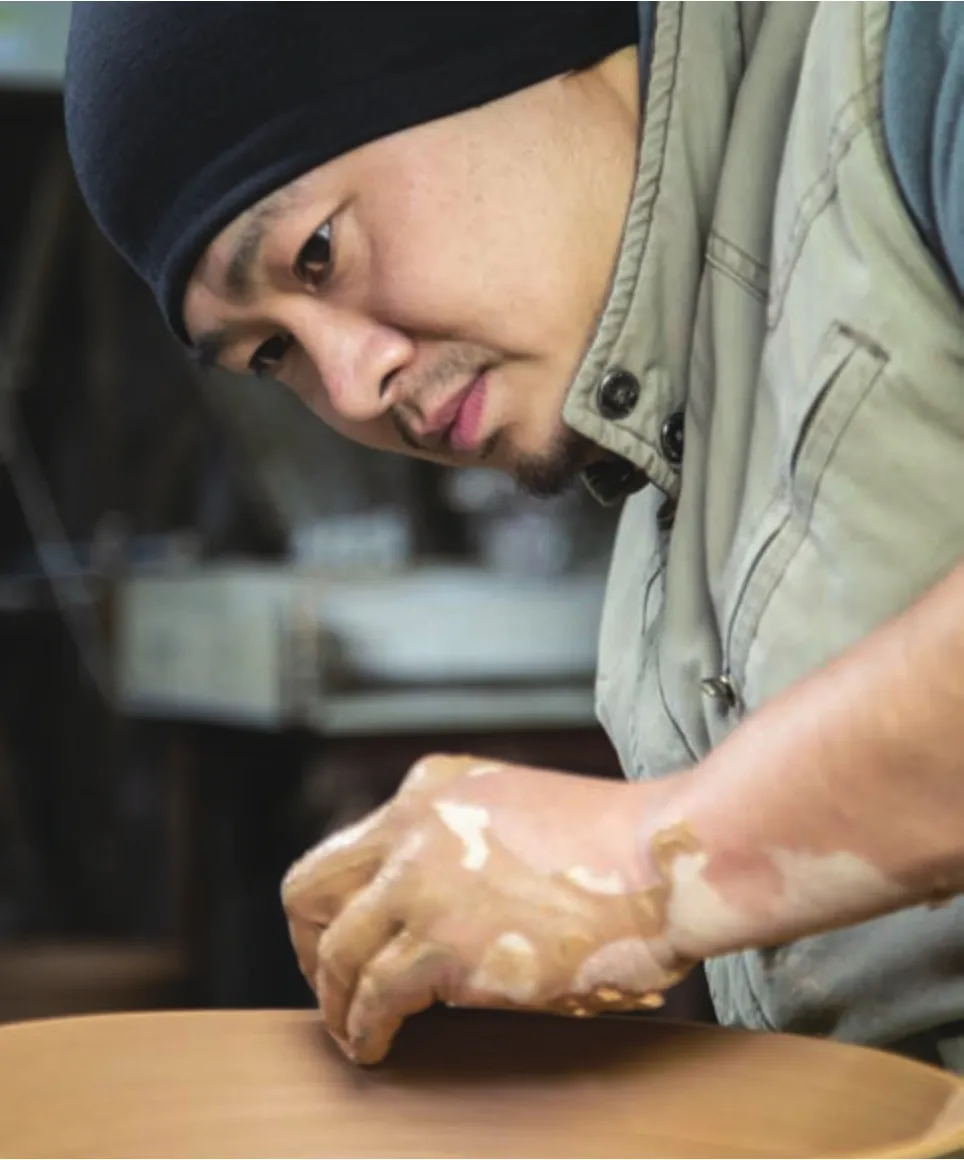
孙威。Sun Wei.
这些来自游人的“作品”,摸上去还有热乎乎的炉温,有些甚至并不具有完整的器型,但孙威很在意它们,小心翼翼地将其置于桌面的空阔处,随后,它们将被一一送至“创作者”手中。
其实我有点失望。
一位越窑青瓷烧制技艺传承人,竟然毫无我事先想象的岁月感。
孙威是一位80后。而他的青瓷人生,在经过儿时跟随父母的耳濡目染之后,正式开启于二十八九岁—那是他从大学里的体育专业毕业,当了两个月的体育老师,又经历数次创业失败而“认命”的结果。
我被他的经历震撼,甚至被催生了一种妄想—是不是我也可以改变,改变既定的人生轨迹,去寻找截然不同的生活?
孙威就是这样的年轻人,在给予青瓷之美的同时,又给出某种人生启示。当如我这般的“妄想”化为行动,说不定,真的可以。
大概所有的成功故事,都离不开勤奋投入的细节。
所以,当我几乎忘记这次不期而遇的全部时,有一点却始终不能忘怀。
孙威的义父,著名陶瓷艺术家高峰曾问他—你想怎么做陶瓷啊?孙威回答—反正拉胚拉好,刻花刻好,烧窑烧好就好了嘛。
不行。
要做好陶瓷,高峰的建议是先得把上林湖周边的山都跑一跑,把那些泥都挖回来烧一烧。孙威照着义父的话,把上林湖周边凡是曾经有古窑的山,都跑了一遍,把那些泥土挖回来,淘洗、烧制。
跑完上林湖周围的山,再开始备料拉胚,孙威就得心应手了。
一方水土,造就一种器物的形态。
所以,沙埠与上林湖的青瓷,有肉眼可见的不同。
在黄岩博物馆,看那些宋时瓷器,我又想到王希孟的《千里江山图》。黄岩的多数青瓷,比青翠浅,比鹅黄深,有时光印刻之下的坚硬痕迹,对应的是“千里江山”中山峰与大地之间最为广大且普通的颜色—那正是江山的本色。
黄岩沙埠窑青瓷与上林湖越窑青瓷,二者的胎釉化学成分组成大致相似。在考古专家的论文中,我读到它们都是用本地产的瓷石单一原料配制而成。但细究起来,沙埠窑青瓷的胎釉氧化铝含量偏高,其硬度就高。二者色泽的差异,则源于釉中的氧化钛和氧化铁成分有异。
是的,每一种色彩都是大自然的无私馈赠。正如沙埠竹家岭青瓷坊的主人谢振威发在微信朋友圈的那句话:瓷是土的一种极致表现。
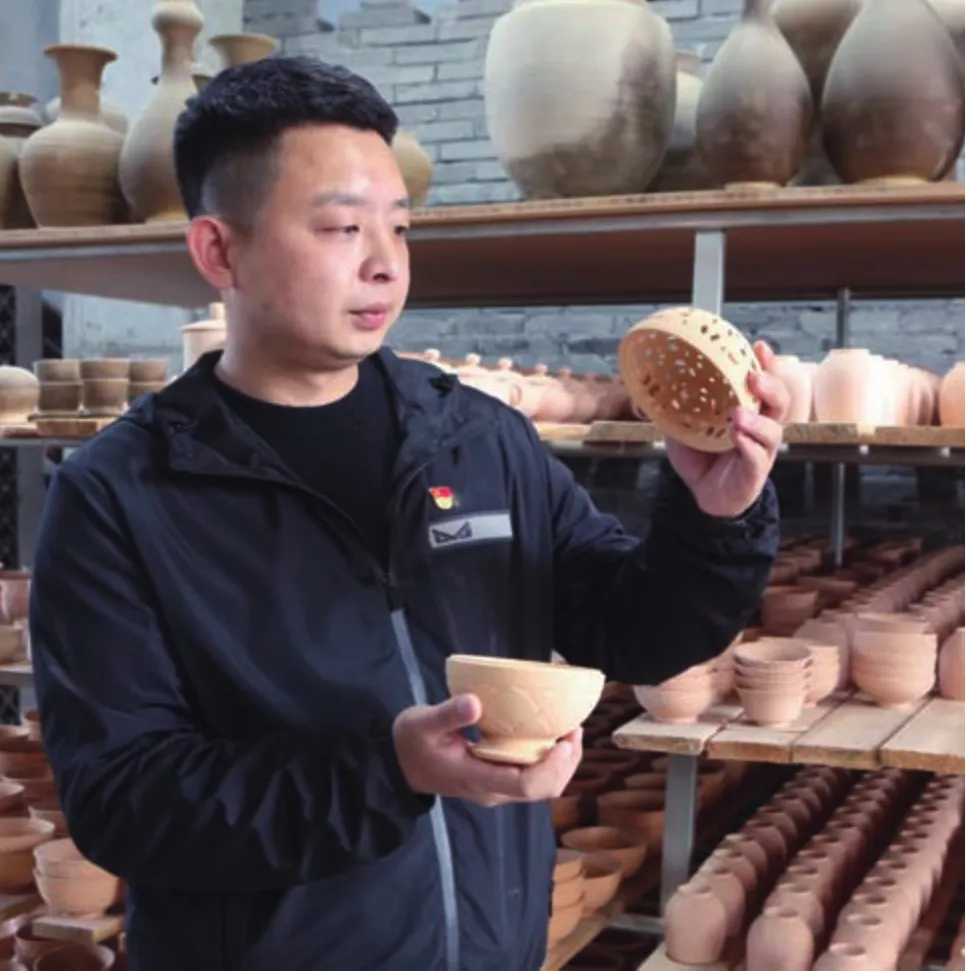
谢振威在研究青瓷器型。Xie Zhenwei looks at an unglazed ware.
谢振威是一位90后,“返乡创业者”是他对自己的形容。
失传800多年的沙埠青瓷制作技艺,正在这位年轻人主持的青瓷坊中得以重生。以青瓷香炉、青瓷执壶领衔的沙埠青瓷精品,不断在竹家岭青瓷坊中成型、生长。
不得不佩服这一代年轻人的信念与勇气—在多数人看来,一处窑址的发掘与保护,除了和当地人的耕种与居住有所关联,大抵对人生并无太大影响。但家距竹家岭窑址仅有200米的谢振威却因此作出一个重大决定。
那是2019年,在考古专家的挖掘与研究中,包括竹家岭窑址、凤凰山窑址在内的7座晚唐、北宋时期沙埠窑址群名声大噪,并获评国家重点文物保护单位。谢振威开始重新打量那些童年时在田间地头轻易就能捡拾到的瓷片。他想的是,能否重燃沙埠的窑火。
在此之前,3位来自龙泉的青瓷匠人租赁了谢振威家的房子,用以生产青瓷,但生意未如想象中顺遂,就在他们准备退出之时,谢振威接下了这个作坊。
青瓷是文化,是生活,也是这一代年轻人不避讳谈及的一门有“钱途”的生意。别人做不好的事情,从零开始的谢振威是否能做得好?
谢振威有他的路径。这一代人有这一代人的路径。显然,他们对时代脉动与人生现场,有更为强大的感受力。
现代制瓷工艺,各地大致相同。差别的产生,在于材质,在于手感,在于匠人对于美的感知。所以,对还是门外汉的谢振威而言,重生沙埠青瓷,难,也不难。
除了一趟趟去龙泉、景德镇等地请教制瓷高人,他与身居上林湖畔的孙威一样,花大量时间泡在博物馆中,以目光触摸那些“镇馆之宝”的纹理、色彩,感受其与众不同的气质。
竹家岭青瓷坊的主打产品,是沙埠青瓷工艺最为复杂的青瓷香炉。那件黄岩博物馆的北宋沙埠窑青瓷香炉,谢振威不记得去看过多少次。它的底盘与盖子分离,镂空的半球型的盖子饰以三瓣卷叶缠枝忍冬纹,要呈现那些弯弯绕绕的线条,需要镂空、刻划、浮雕等诸多手法并用。
对于那些繁复,如今的谢振威已经了然于胸。于是,各种尺寸的青瓷香炉,也由这间青瓷坊迈进普罗大众的生活。
上林湖,沙埠溪,在不同的水畔听闻年轻人对青瓷的追寻,总让人想起舞剧《只此青绿》中王希孟对一纸青绿的追求。
十八岁的少年王希孟,在宋徽宗的点拨下,挥就一卷青绿江山,而后跃入时光的长河,杳然无踪。
如果不是借由一方舞台的想象,我们无法沉浸于宋代的“青绿”与江山,也无法体会一位年轻画家那些具体的犹疑、陈思、畅怀、狂歌……而青绿,由画中气象凝身为一位美丽的女性,她的每一次隐与现,都蕴含画家的求索或怅然。
天下之大,即使回到千年之前,王希孟这样的天才型少年也并不稀缺,可他为何能获得宋徽宗的青睐,宰相蔡京的托举,又让不为人知的身世承载无尽的迷思?
后世学人都在构建着王希孟的形象,可那些,未必就是真正的他。即便如此,我们还是记住了这位从北宋走来的少年,历史仅为他留下三言两语,他却穿过千年,叫人惦念。其原因,就是《只此青绿》里表达的那样—除了他,还有谁能为纸上的千里江山拼尽全力。
在属于青瓷的青绿当中,我同样看到了年轻人的全力以赴。
回到我踏足的那片竹家岭窑址,800多年前,它度过了北宋中期到南宋初期的兴盛时代,窑火渐熄。可是,当我们走近并了解它的故事,会觉得它是越窑的延续,龙泉窑的号角。即使腾挪场地,技术一直在流传,叠加,遇到合适的土壤,就会迸发光华。
正因如此,走进那些古窑附近的村落,总会不经意间遇见年轻的手艺人创造的传奇—往昔的青绿,焕发着今日的色彩。
千年前的王希孟孤身一人,但为青瓷而生的“王希孟”就在今天这一片水土之上。
他们的故事,卧在山坡的“龙窑”一定知道。
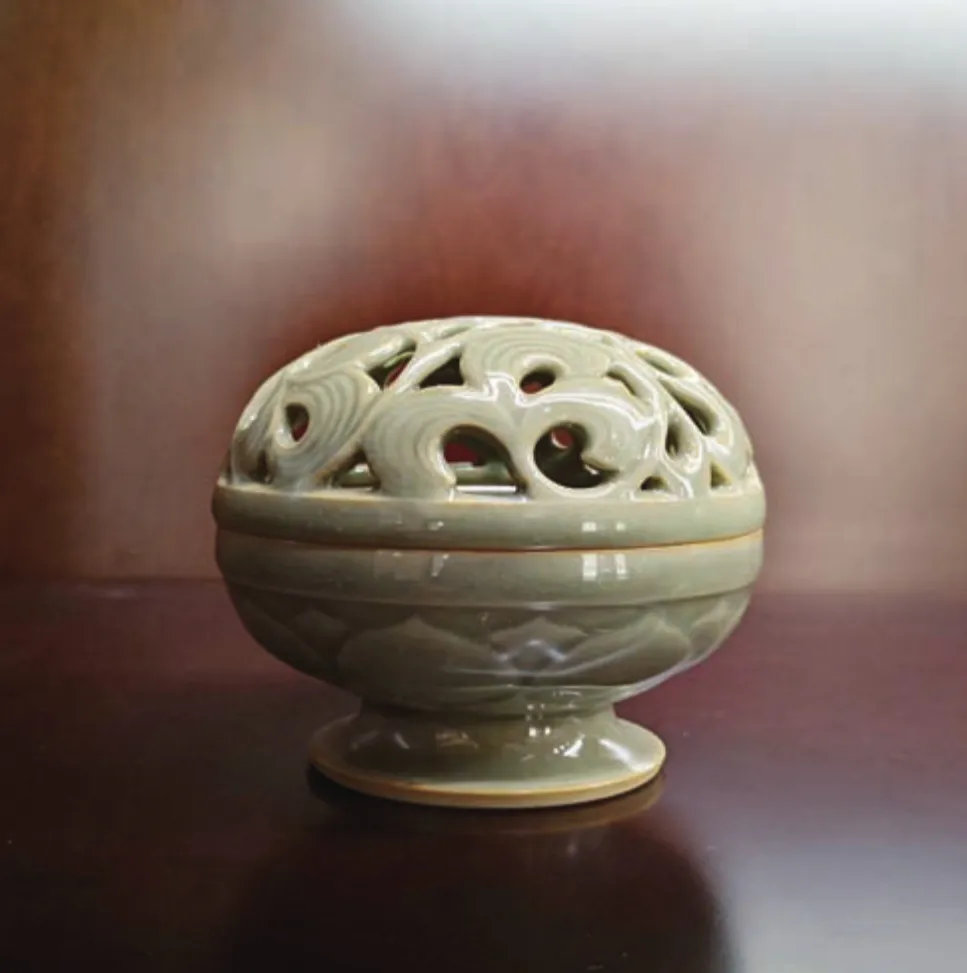
谢振威的青瓷作品《青瓷薰炉》。Celadon Incense Burner, a work by Xie Zhenwei.
Verdent Green and Young Craftsmen
By Sun Wen
The Song dynasty (960-1279) is not far away.
At the bottom of the Zhujialing, it seems that if you could walk past the sharp stare of the security guard, you could land on the great land of Song. Even if you don’t step inside the iron gate,at the foot of the hill next to the asphalt road you can also look up and see it right there.
A dragon kiln perches on the hillside of the Zhujialing kiln site at Shabu township, Huangyan district, Taizhou city. Looking at the wares fired by the dragon kiln, you could see vividly the lives of people living by the creek of Shabu. And then, the ceramics fired by the dragon kiln coming in different shades of green have traveled along the water to the Yongning River and the Jiaojiang River, and then rode the blue waves of the East China Sea to the rest of the world.
Stand at the top of the mountain and look down —
You could find between the mountains, there is a large flat area, just like the flat expanse depicted inby Wang Ximeng (1096-1119), a young painter of the Northern Song dynasty (960-1127). It is not hard to visualize the busy water traffic here hundreds of years ago.
I arrived at Huangyan on an early summer day, and my view was fully filled with verdant and green. There were scattered lightcolored flower trees interspersed in the dense forest, showing a color arrangement coinciding with that of celadon unearthed in Zhujialing.
Before going to Huangyan, I also went to Cixi in Ningbo city.
Cixi porcelain and Huangyan porcelain, viewed professionally,are different in many ways. But to an amateur like me, I just love their smooth green tones, whether dark or light, rendered with craftsmen’s solemnity or playfulness.
I don’t know whether it is a coincidence or not, but when I step into the villages near those ancient kiln sites, I always meet young people who “live in seclusion”. They are taking care of the old things of the land, but of course, with a new concept and new equipment.
I met Sun Wei in the village of Zhanlong in the town of Kuanyan, on the shores of the Shanglin Lake. He was carefully removing several small celadon pieces from the kiln and bringing them to the large table in his studio.
These “works” from tourists still felt warm from the kiln and some could not even be counted as fully shaped. But Sun cared about them and carefully placed them on the table — later they would be delivered to their “creators” one by one.
I was in fact a little disappointed. An inheritor of celadon firing techniques of Yue kiln is not weathered as I had imagined.
Sun is a post-80s (born after the 1980s) generation, whose career in celadon, under his parents’ influence since his childhood,officially started at the age of 28 or 29. That is, after he graduated from college in physical education, taught as a PE teacher for two months, and failed in several entrepreneurial attempts.
Suni’s adoptive father, a famous ceramic artist named Gao Feng, once asked him, “How do you want to make ceramics?” Sun replied, “Perform well in molding, carving, kiln firing, and that’s it.”
And that is far from enough.
To do a good job in ceramics, Gao advised him to first go to the mountains around the Shanglin Lake, to dig back some clay from there and put it into the kiln to see the results. Sun followed Gao’s words. After familiarizing himself with the mountains around the lake, Sun started to prepare the materials for molding,and then he was able to do it with ease.
Water and soil of a particular region creates a unique form of wares.
Take the celadon of Huangyan Shabu kiln and the celadon of Shanglin Lake Yue kiln as an example. In general, their glaze chemical compositions are similar — I read in some archaeological expert’s paper that they are both made of locally produced porcelain stone as the single raw material. However,on closer examination, the Shabu kiln has a relatively higher alumina content in its glaze, and is thus harder. And they are a little different in color because of they have different amounts of titanium oxide and iron oxide in their glaze.
Xie Zhenwei was born in the 1990s and he describes himself as a “home-returning entrepreneur”.
The celadon-making skills of Shabu celadon, which have been lost for more than 800 years, are being reborn in the celadon workshop presided over by this young man. The Shabu celadon products, represented by incense burners and pots, continue to take shape and grow in the Zhujialing celadon workshop.
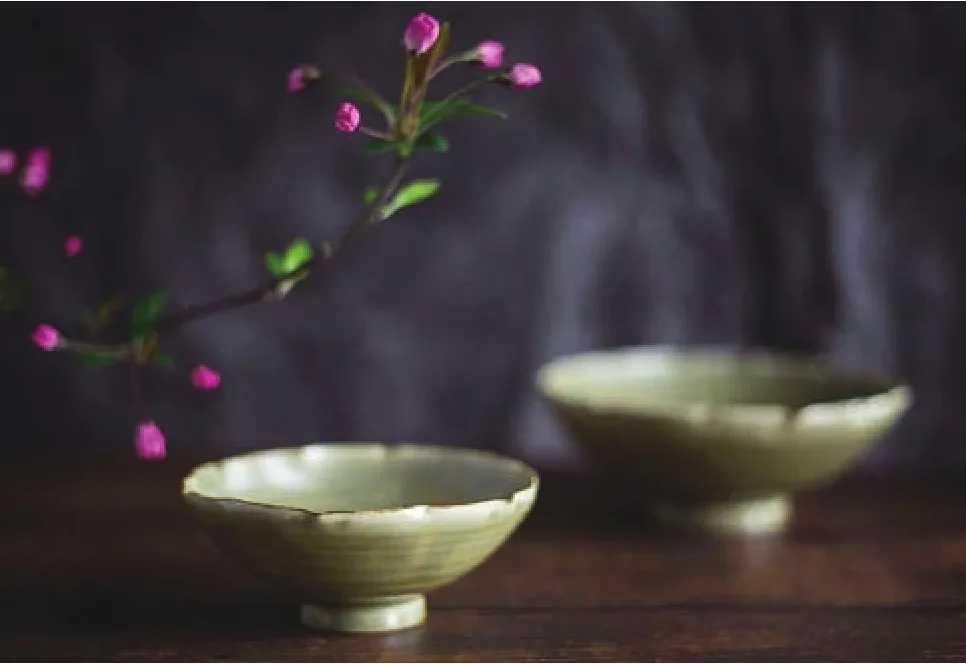
孙威作品《桃之夭夭》。Splendid Peach Blossoms, celadon works by Sun Wei.

沙埠青瓷制作过程模型。A miniature model showing the celadon-making process in Shabu.
I have to admire the vision of this generation of young people— in the majority’s view, the excavation and protection of a kiln site, apart from having something to do with local people’s farming and housing, generally do not have much impact on people’s lives.
But Xie, whose home is only 200 meters away from the kiln site in Zhujialing, made a major decision accordingly.
It was 2019, during the excavation and research by archaeologists, a group of seven Shabu kiln sites from the late Tang(618-907) and Northern Song dynasties including the Zhujialing kiln site and the Fenghuang mountain kiln site, became wellknown and was recognized as a National Key Cultural Relics Protection Unit.
Xie began to re-examine the porcelain pieces that he could easily pick up in the wilderness as a child. He wondered if he could rekindle the kiln fire in Shabu.
Before that, three celadon craftsmen from Longquan rented Xie’s house to produce celadon, but their business did not go as smoothly as expected. When they were ready to quit, Xie took the workshop over.
Modern porcelain production processes across different regions are pretty much the same, for the differences lie in material, texture, and the artisan’s perception of beauty. So, for Xie the layman, reproducing Shabu celadon could be difficult — or not difficult at all.
Apart from travelling to Longquan, Jingdezhen and other major porcelain-producing places to consult the masters, Xie spends a lot of time in the museum, closely examining “treasures of the town” for their texture and color and feeling their distinctive temperament.
The main product of the Zhujialing celadon workshop is celadon incense burner, most complex to make of all Shabu celadon. Xie can’t remember how many times he has visited the Huangyan Museum for observing its Shabu kiln celadon incense burner of the Northern Song dynasty. Its chassis is separated from the lid, and the hollowed-out, hemispherical lid is decorated with a pattern of three-valve scrolling leaves entwining with branches.To reproduce those curved lines requires many techniques of hollowing, incising and relief carving.
Now Xie is already a master in achieving such complexity. As a result, celadon incense burners of various sizes keep coming out of this celadon workshop and into local people’s daily lives.
Young people’s pursuit of making the best celadon always reminds me of Wang Ximeng’s pursuit of presenting the utmost green in his painting.
The 18-year-old Wang Ximeng, under the guidance of Emperor Huizong (1082-1135) of the Song dynasty, put up a scroll featuring a beautiful green tone and then leapt into the river of time, disappearing without a trace. Scholars of later generations have never stopped trying to construct an image of Wang, which,however, may not be the real him.
Even so, we still remember this young man who came from the Northern Song dynasty, who has dedicated himself to creating a vast, magnificent stretch of rivers and mountains of his motherland with his paint brush.
In the young celadon artists, I also saw the full commitment.Walking into the villages near those ancient kilns, one will always be surprised to see beautiful celadon created by young craftsmen— the celadon started off as a green legend of the past but is now glowing with the hues of modern times.

永宁江。蔡志敏/摄The Yongning River. Photo by Cai Zhimin.

